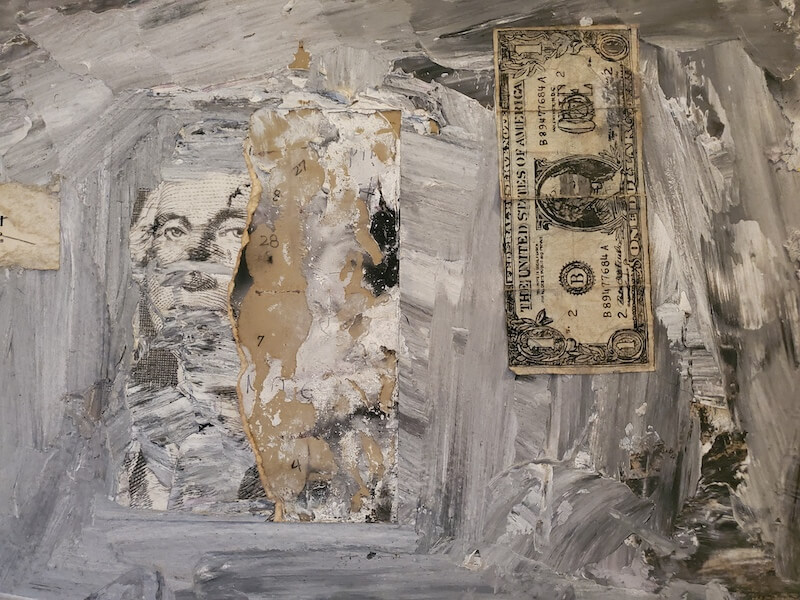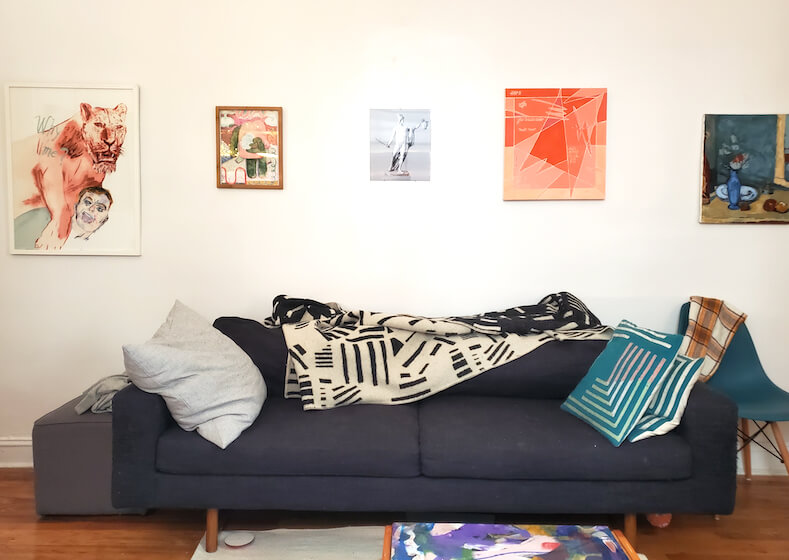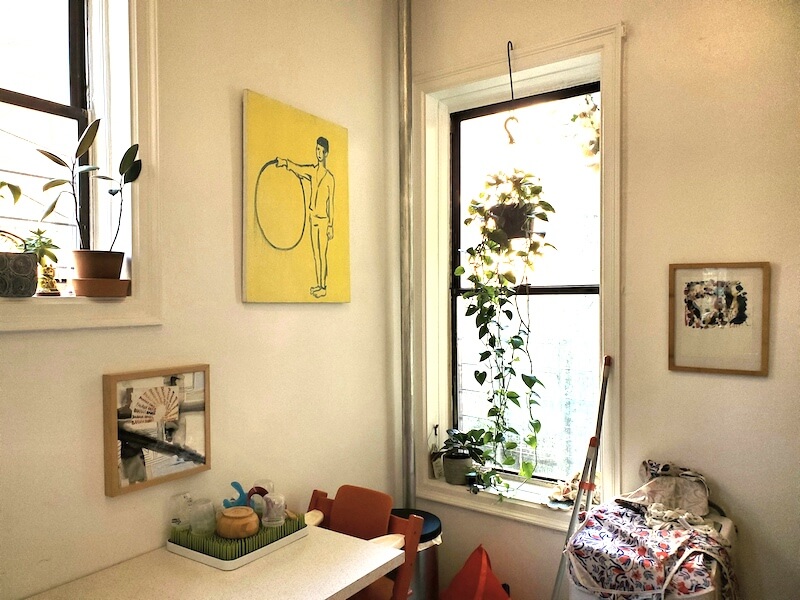- What exactly is Extra Coverage?
- Does Lemonade cover every type of art?
- If I’m an artist, can I insure my own paintings or sculptures at home?
- Does the artwork have to be hung up in my house for it to be covered?
- How much art can I buy Extra Coverage for?
- The value of an artwork can fluctuate. How is that factored in?
- What sort of documentation do I need to insure my art?
- What if the artwork was a gift?
- If I get Lemonade’s Extra Coverage, what specific things is my art protected against?
- So who’s a good candidate for Extra Coverage on art, and who isn’t?
They say art is in the eye of the beholder. But what happens if you’re holding it—and then drop it?
Oh, how easy it is for a fancy sculpture to become a pile of ceramic shards. Or for a house fire to burn up that oil painting above the couch. If there are a million ways to define what art is, there are another million ways for works of art to get damaged or destroyed.
Now, if you’re a big-time collector—with a Jeff Koons balloon dog in your backyard, and a KAWS in your bathroom—you’re going to want to get your bounty covered by an insurer that specializes in fine art. But if you’re more of a modest dabbler who owns a few drawings or prints by up-and-coming artists, it’s quite possible that your collection could benefit from adding Extra Coverage under a Lemonade renters or homeowners policy.

Below, we’ll give you a refresher on what Extra Coverage means at Lemonade—it’s essentially our snappier-sounding name for ‘scheduled personal property coverage’—and we’ll walk you through some scenarios to show you how this insurance can help protect your artworks.
What exactly is Extra Coverage?
Extra Coverage is an add-on to your base renters or homeowners policy that’s meant to provide additional insurance perks for things like cameras, jewelry, bicycles, and musical instruments.
There are a lot of benefits to adding Extra Coverage: you won’t pay any deductible on your claims; you’ll be covered for higher dollar amounts; and you’ll also be set for things your base policy doesn’t cover, like accidental damage or loss.

You can learn more than you’d ever want to know about the ins and outs of Extra Coverage by reading our guide here.
Does Lemonade cover every type of art?
Extra Coverage is restricted to certain mediums: paintings that hang on the wall; photographs; serigraphs and lithographs (types of prints); and sculptures, on a case-by-case basis.
This add-on insurance coverage won’t cover things like framing. And it won’t cover items like rugs, collectibles, or memorabilia—which is not to say that your collection of 10,000 Pez dispensers or toy robots isn’t a work of art in its own right.

BTW, your basic renters or homeowners insurance does cover these same type of artworks against specific named perils, but only for their Actual Cash Value. That’s a fancy way of saying you’d only be reimbursed for the cost of the physical materials that went into the specific piece, like paint or clay—not for the value the object magically achieves once it’s seen as a work of Art, with a capital A.
If I’m an artist, can I insure my own paintings or sculptures at home?
Not with your renters or homeowners insurance policy. Extra Coverage isn’t able to cover artworks made by the policyholder or by other members of your household.
If art is your career, you’d want to purchase business insurance to cover the work you make—protecting it for the value of what you would’ve earned if you had sold the piece through your gallery, for instance.
Does the artwork have to be hung up in my house for it to be covered?
Nope. As long as it’s in your house somewhere, or at a location covered by your renters or homeowners insurance policy, it’s protected. If your painting is being stored in a closet, that’s fine. And if you take your artwork on the bus because you want to show it off to your mom across town? Well, if it gets stolen in transit… you’re also good to go with Extra Coverage.
The big exception here is if the damage is intentional. If you get in an argument with your spouse, and he decides to chuck that cute little Fernando Botero sculpture off the balcony… you both are out of luck.
How much art can I buy Extra Coverage for?
You can get Extra Coverage for up to $20,000 worth of artwork, total. That could be one major artwork that’s worth $20,000, or twenty pieces each worth $1,000, or—you get the idea.
The value of an artwork can fluctuate. How is that factored in?
If you’re a fan of contemporary art, you know how wild and unpredictable the art market is. A drawing that a savvy collector buys for $500 might, within two years, be selling at auction for $15,000. (Crazy, you say? We won’t argue with you there.)
Anyone purchasing artwork for an investment is probably going to be looking for the sort of specific, fine-art focused insurance we mentioned earlier. With Lemonade’s Extra Coverage, we base the value of the artwork on an appraisal or receipt submitted when you add the coverage. We’re typically not taking appreciation or depreciation into account.

That said, if you have a hunch that the work you bought back in 2001 is now worth a lot more, you can request a Replacement Cost Appraisal for the piece and submit that to our team to review. But keep in mind: replacement cost is different than current market value.
TL;DR: The typical candidate for Lemonade’s Extra Coverage on art would be someone who purchased a painting from a local gallery for $3,000. Years later, that painting is probably still worth around $3,000… it’s not suddenly appearing for sale at Sotheby’s for $300,000.
Anyone who is collecting the sort of big-ticket artwork whose value might climb over time would be better suited for dedicated fine-art insurance, which Lemonade does not offer.
What sort of documentation do I need to insure my art?
You can school yourself in the intricacies of Extra Coverage documentation here (we make it more fun than that sounds, promise). But essentially we need proof of possession, ownership, and value.
That means we need fresh, ideally time-stamped photos of the artwork in your home, to confirm that you actually have it in your possession. Then we need a receipt or an appraisal dated within the last five years, and made out to either the insured or the secondary insured.
This appraisal needs to be completed in-person, not through an online appraisal service.
What should an appraisal include beyond those names? You’ll want it to state the insured’s address; the date of appraisal; the value of the artwork, and a detailed description of it; the name and signature of the appraiser (not an e-signature); and the appraiser’s contact info, including address, phone number, and/or email.
What if the artwork was a gift?
Three cheers for generous, creative friends! That’s no problem. We’ll need an appraisal made out either to the insured, or to the person who gave the artwork as a gift. Then we’ll need proof of the transfer of ownership, to confirm that you actually own the art—that could be something like an email confirming the details, or a gift receipt.
If I get Lemonade’s Extra Coverage, what specific things is my art protected against?
Extra Coverage gives you…um…extra protection that your base policy does not. It protects your artwork against a suite of around 16 named perils—things like fire, vandalism, and theft—but also includes coverage for accidental damage and “mysterious loss” (a spooky way of saying you can’t find something and you have no idea what happened to it).

With Extra Coverage, your artwork is essentially covered against a peril unless your policy specifically states otherwise. Lemonade’s Extra Coverage, for instance, excludes nuclear accidents. So if your sculpture is vaporized by a nuclear bomb, it’s not covered. You’d probably have slightly bigger problems to deal with, anyway. Oof.
Tons of other common scenarios are covered. If you knock your own sculpture over, you’re likely covered, on a case-by-case basis. Let’s say you hosted a wild dance party for 100 guests, and your sculpture was damaged when someone twerked into its pedestal in the middle of the living room…you’d likely be covered (but you probably should have moved the work into the safety of a bedroom).
If you’re rehanging your favorite print and you accidentally scratch, smash, or rip it in the process, you’re covered. Keep in mind, though, that the print itself would be covered—not any frame it’s in.
And if a raccoon sneaks into your house and decides to devour your favorite painting? Lemonade’s Extra Coverage has your back. Sort out that raccoon problem though… those guys are adorable, but they can be vicious.
Certain types of damage definitely aren’t covered, including anything that you caused intentionally. Let’s say you read something on Twitter that made you angry enough to throw your phone at a delicate sculpture… which then exploded into a million pieces. In that case, Extra Coverage would not apply. And you should probably get off Twitter.
So who’s a good candidate for Extra Coverage on art, and who isn’t?
Avid collectors purchasing expensive artworks whose value might climb over time are probably not good candidates for Extra Coverage. If you’re one such mover-and-shaker, you’ll probably want to look into high-end art insurance from an insurer like AXA XL or Chubb. Plus Lemonade’s Extra Coverage maxes out at $20,000 in total… and many coveted pieces of contemporary art might be priced at $200,000 for a single painting.
But if you’re a new collector with only a few pieces in your home—or one snazzy, slightly expensive painting that’s the centerpiece of your living room—consider Extra Coverage as an add-on to your renters or homeowners insurance with Lemonade! It’s an easy way to make sure that your masterpieces are a little more secure.
A few quick words, because we <3 our lawyers: This post is general in nature, and any statement in it doesn’t alter the terms, conditions, exclusions, or limitations of policies issued by Lemonade, which differ according to your state of residence. You’re encouraged to discuss your specific circumstances with your own professional advisors. The purpose of this post is merely to provide you with info and insights you can use to make such discussions more productive! Naturally, all comments by, or references to, third parties represent their own views, and Lemonade assumes no responsibility for them. Coverage and discounts may not be available in all states.




